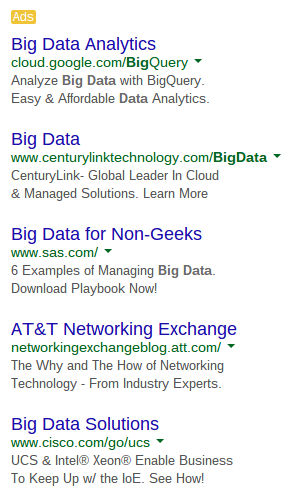Today, we’re going to cover the biggest mistakes beginning PPC marketers make, industry best practices, and practical tips to implement these ideas.
The 3 Most Common (And Easy to Fix) Mistakes on PPC post-click landing pages:
1. Not writing enough ads
Most people try one ad with a dozen variations, instead of actual testing separate distinct ads. Don’t get me wrong – this is a good start.
Let’s pick a buzzword that’s sure to try and sell us something because we’re marketers… I’m going to choose “big data” for this example:

As you can see, the ads are all very similar and use language that isn’t particularly original. You can easily stand out just by seeing what your competition is doing and zigging when they zag.
2. Failure to ad match
Don’t confuse people. Use similar language and consistency in your approach as you guide them from an ad to your post-click landing page. Too many brands focus on creating the perfect ad… And then completely fail to follow up it up with a post-click landing page to match.
Message matching makes all the difference in PPC campaigns.
3. Asking for too much information
In most cases, it pays to stick to short forms. If you ask for too much information right at the beginning, your potential user has a higher rate of bouncing.
Think of it like a dating relationship. Would you ask someone for their life story on a first date? Probably not. (And if you did, they’d probably think you were strange. No second date).
It’s the same when a new user lands on your post-click landing page for the first time. Get the minimum amount of information you need to get them what they want. Focus on getting the second date.
So we’ve covered what not to do and to fix it. Now how can you really improve upon this? Check out these best practices to help guide the creation of the perfect post-click landing page for your PPC campaign.
The Top 5 PPC post-click landing page Best Practices:
1. Determine post-click landing page goals
It should go without saying, but actually setting up a goal for your campaign is the single most effective thing you can do.
It’s hard to measure how effective your page without setting smart goals. Are you hoping to generate a certain number of leads? What kind of conversion rate would be good, better, and best for this campaign? After you set your goals, the most important part of post-click landing page creation comes in…
2. Test, test, test.
A/B test your post-click landing pages. Split test your ad headlines and copy and form length. PPC requires constant moderation because it is so dynamic. You’ll need to keep an eye on keyword bids to get rid of expensive words that don’t perform as well.
This article by the PPC wizards at WordStream is a great primer of how to go from basic testing to epic testing.
3. Optimize for mobile
You’ve probably heard about Mobilegeddon this week. It’s Google’s next big mission to form the web in their favor, and it’s going to work – which means your pages better be mobile friendly if you want them to rank well.
While most marketers don’t think this will be the year mobile search overtakes desktop search, they all agree it is coming – and fast. By the end of 2015, half of all ad spend is predicted to be spent on mobile specific ad placement.
Cross-device conversion tracking is the direction PPC is heading. Remarketing and how it’s done will continue to become more sophisticated across channels. You need to be ready for the inevitable (and awesome) traffic you’ll be getting from mobile.
Sound scary? Don’t worry – we’ve got your back. There’s an Instapage update coming soon that will let you turn your page in a mobile responsive post-click landing page in a click. (Make sure you sign up so you get first access!)
4. Automation is essential
PPC is effective – and it can also be time consuming, if you’re not careful. Everything should be integrated, connected, and automatically getting you the data you need to make smarter decisions with your advertising dollar.
If you’re not using Mixpanel or something similar, you need to be. Track clicks, automate remarketing efforts, and you can make sure you are there for your user exactly when they need you to be.
Pro tip: Instapage has tons of integrations to automate your post-click landing pages, from your favorite email marketing software to your CRM tool. Connect your tools and get your leads on your list faster.
5. Focus on the long game – with long-tail keywords
Long-tail keywords are the more specific words your audience is searching with to find you – and that’s great news! Long-tail keywords are by their nature cheaper and less competitive because most people are so focused on the head keywords.
Pro tip: For better organic ranking, push to dominate long-tail keywords that are performing well for your campaign.
With these best practices under your belt, your PPC post-click landing pages will start performing at the levels you want.
Always connect all your ads to personalized post-click landing pages to lower your cost per customer acquisition. Start creating your dedicated post-click pages by signing up for an Instapage Enterprise demo today.

See the Instapage Enterprise Plan in Action.
Demo includes AdMap™, Personalization, AMP,
Global Blocks, heatmaps & more.
